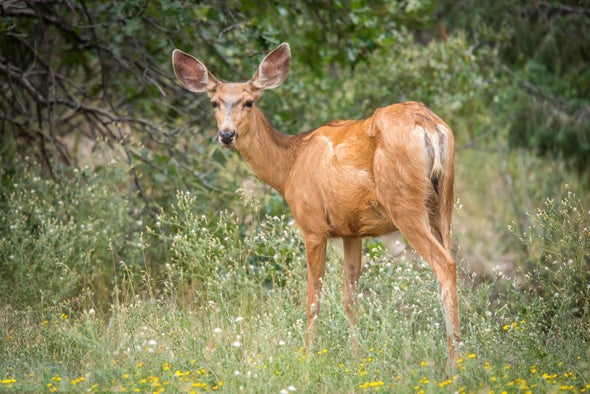(单词翻译:单击)
听力文本
This is Scientific American's 60-second Science, I'm Scott Hershberger.
Climate change is altering the migration routes of animals worldwide. Here's a look at new research on how two species have been affected.
First, mule deer. Every spring in Wyoming, vegetation first appears at lower altitudes before progressing up the mountainside. Migrating mule deer follow and forage on this green wave. But as a changing climate leads to more frequent and more severe droughts, the greenery is not as bountiful as it used to be.
For her Ph.D. research at the University of Wyoming, Ellen Aikens tracked mule deer as they surfed the green wave.
"The green-up lasted across the landscape for about half as long in drought years, in comparison to wet years. And also, the order of green-up along these routes were less sequential. So in essence, drought compresses and reshuffles the green wave and just makes it so that this foraging bonanza that deer depend on in their spring migration is really compressed in time."
And although the deer were able to keep up with the faster green wave, the nutritional value was lower—leaving the animals less prepared for the challenges of the year ahead.

Meanwhile in Europe, the population of Bewick's swans that spend the winter in the United Kingdom and the Netherlands is declining. But when researchers looked at the data more closely, they found an increase in the wintering population of swans in Germany. It turns out that since the 1970s, the swans' wintering habitat has shifted an average of 13 kilometers to the east each year.
"What we think is that the swans like to spend time in areas where it's five degrees Celsius. And this isotherm has shifted in the same rate as the swans shifted eastward. So that's a strong indication for us that the swans actually move with this temperature line."
Rascha Nuijten of the Netherlands Institute of Ecology. Her team also found that the swans were spending less time in their winter homes before flying back to the Russian tundra to breed.
Neither the mule deer nor the Bewick's swan is endangered, but the findings have broader importance for our understanding of the conservation of migratory animals.
"Because if you start thinking of protecting a certain plot of land, it's not just the current situation that is there. Nature is dynamic. And the species that are present now might not be present in 10 years' time—and not because we didn't protect it but maybe because these species are actually dynamic in their ways. And we need to include this resilience and the dynamics of nature into our legislation and management."
Thanks for listening for Scientific American's 60-second Science. I'm Scott Hershberger.
参考译文
这里是科学美国人——60秒科学系列,我是斯科特·赫什伯格。
气候变化正在改变世界各地动物的迁徙路线。下面我们来看一项聚焦两种物种如何受到影响的新研究。
首先是北美黑尾鹿。每年春天,怀俄明州的植被首先出现在较低的海拔地区,之后再向山坡蔓延。迁徙的北美黑尾鹿会跟随这片绿色的波浪并觅食。但是,由于气候变化导致越来越频繁且严重的干旱,绿色植被不再像以前那样茂密。
艾伦·艾肯斯将追踪北美黑尾鹿在绿浪生活的过程作为其在怀俄明大学的博士研究。
“干旱年份景观绿化的持续时间约为湿润年份的一半。而且,迁徙路线绿化顺序的连续性也有所下降。因此从本质上来说,干旱压缩并重新安排了绿浪,使北美黑尾鹿在春季迁徙时所依赖的觅食天堂被及时压缩。”
尽管北美黑尾鹿能够跟上加速的绿浪,但食物的营养价值却变低,这使得这些动物对未来一年的挑战准备不足。
与此同时,在欧洲国家英国和荷兰过冬的比尤克斯天鹅的数量正在下降。但当研究人员更仔细地研究这些数据时,他们发现在德国越冬的比尤克斯天鹅的数量增加了。结果发现,自上世纪70年代以来,比尤克斯天鹅的越冬栖息地每年平均向东迁移13公里。
“我们认为,比尤克斯天鹅喜欢在5摄氏度的地区过冬。5摄氏度等温线的移动速度与比尤克斯天鹅向东移动的速度相同。这对我们来说是个有力指标,说明比尤克斯天鹅实际上是随着这条温度线移动的。”
荷兰生态研究所的拉查努·伊吉滕说到。她的团队还发现,比尤克斯天鹅飞回俄罗斯冻原地带繁殖之前,在越冬地待的时间越来越短。
北美黑尾鹿和比尤克斯天鹅都不是濒危动物,但对于我们理解迁徙动物保护来说,这一研究结果具有更广泛的重要性。
“如果你开始考虑保护某块土地,不只要考虑当前的状态。自然是动态的。目前存在的物种可能在10年后就不复存在,并不是因为我们没有保护它,而可能是因为这些物种以自已的方式动态发展。我们需要将这种自然的弹性和动态纳入我们的立法和管理中。”
谢谢大家收听科学美国人——60秒科学。我是斯科特·赫什伯格。
译文为可可英语翻译,未经授权请勿转载!
重点讲解
重点讲解:
1. in comparison to 与…相比;与…比较而言;
In comparison to city life, life in the country is quiet and peaceful.
同城市生活相比,乡村生活既和平又宁静。
2. in essence 实质;本质;
In essence, your situation isn't so different from mine.
从本质上讲,你我的情况并非相差很远。
3. depend on 依靠;依赖;
Many farmers have to depend on subsidies to make a living wage.
许多农民的基本生活工资要靠补贴来维持。
4. keep up with 跟上(变化等);
It is difficult to keep up with the rapid pace of change.
跟上迅速的变化是很困难的。


